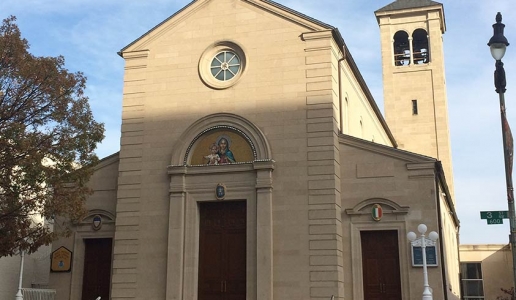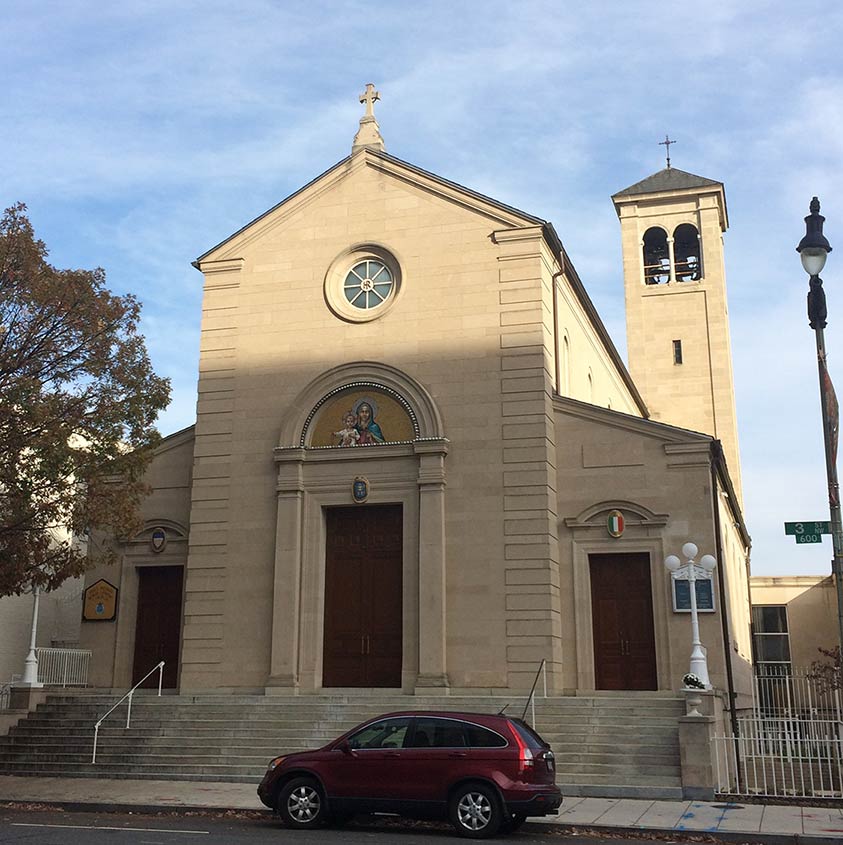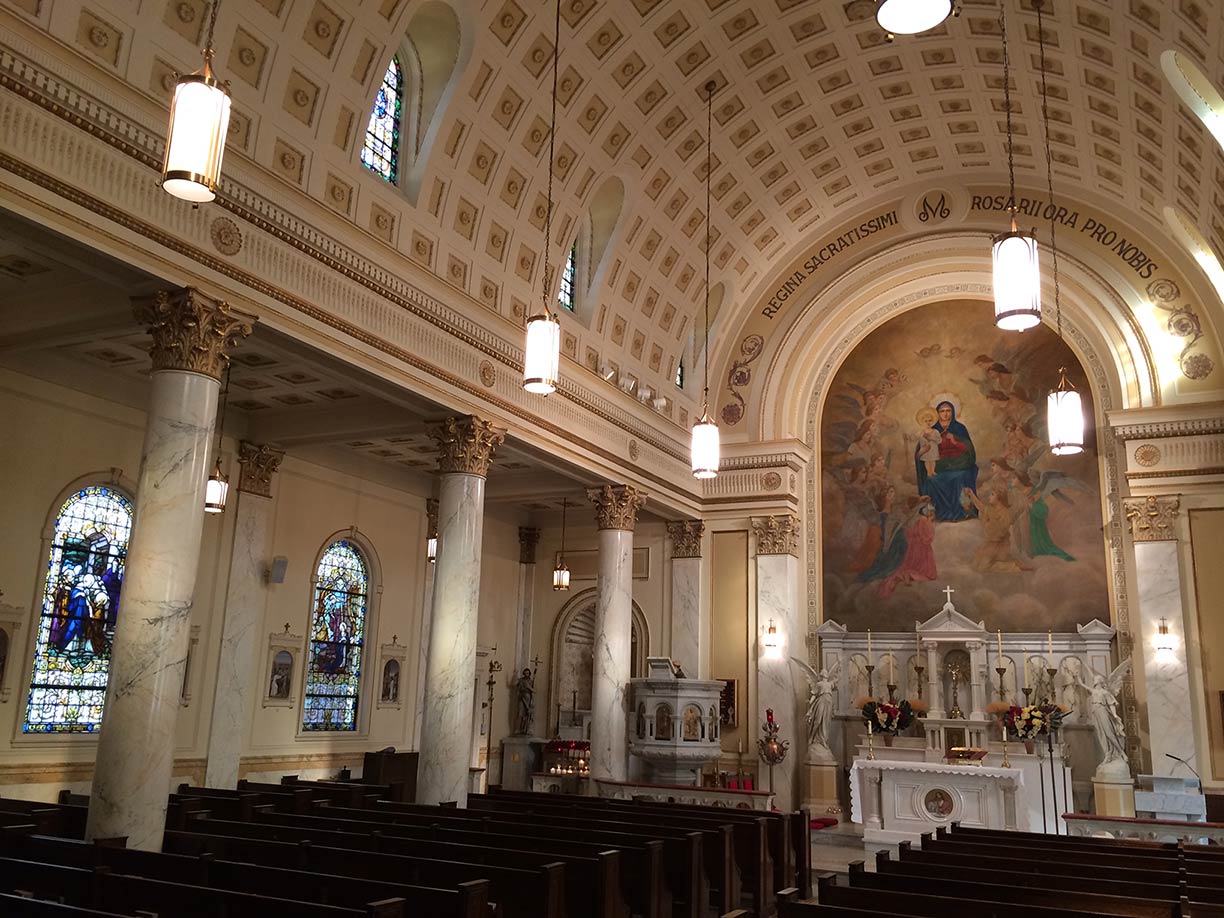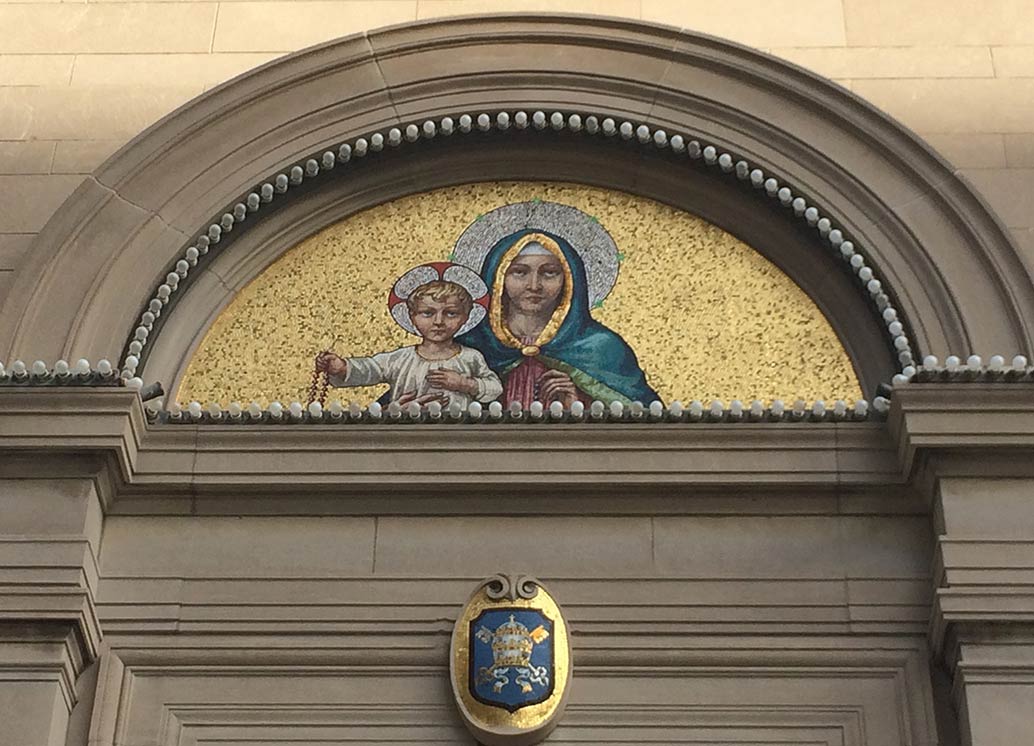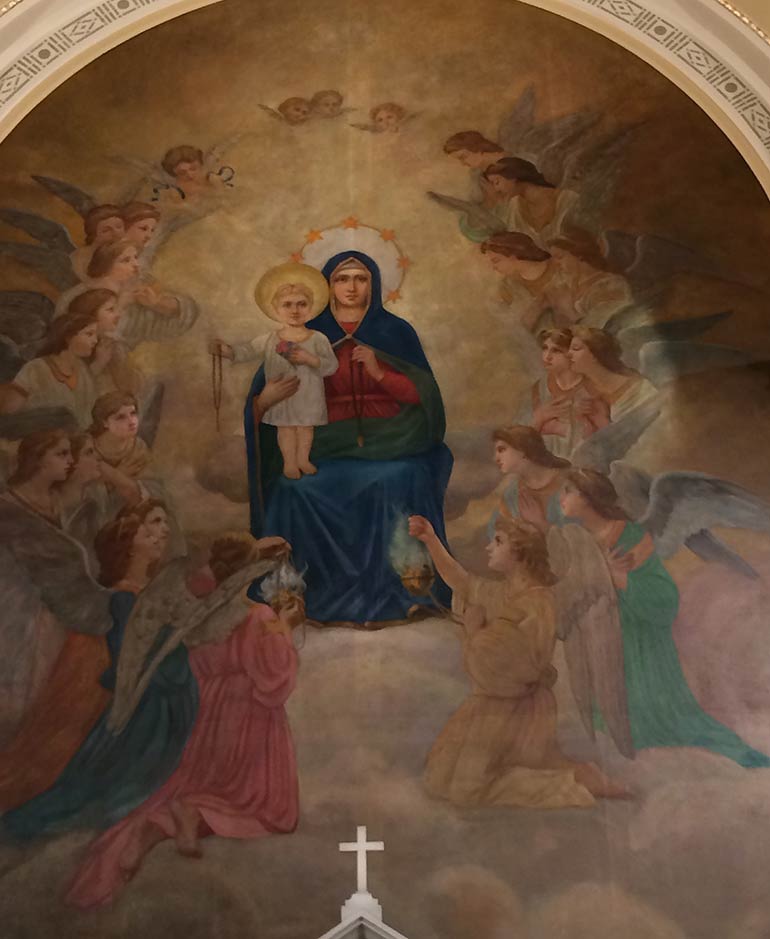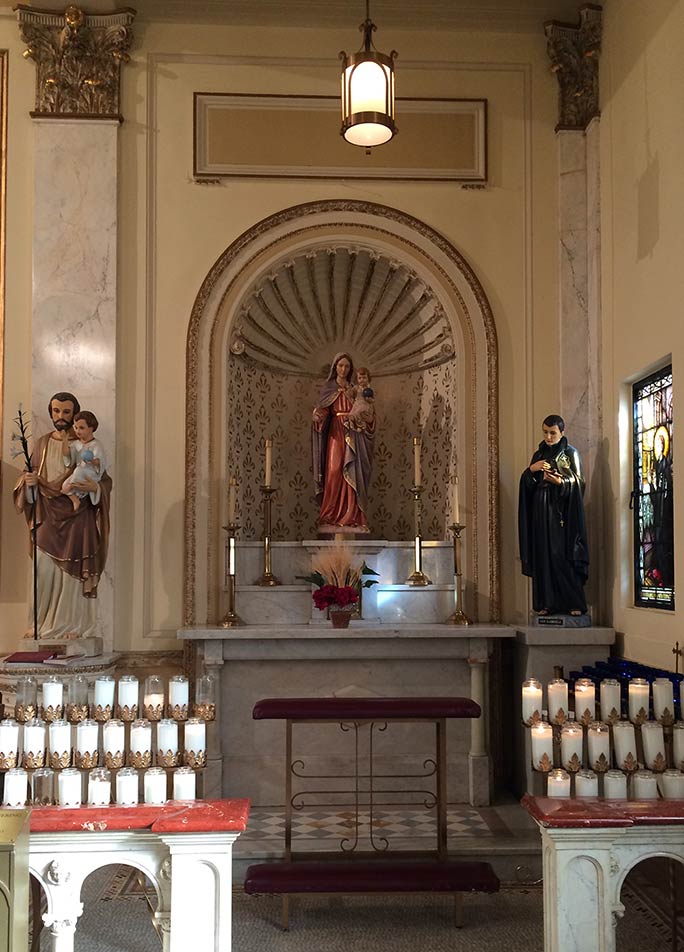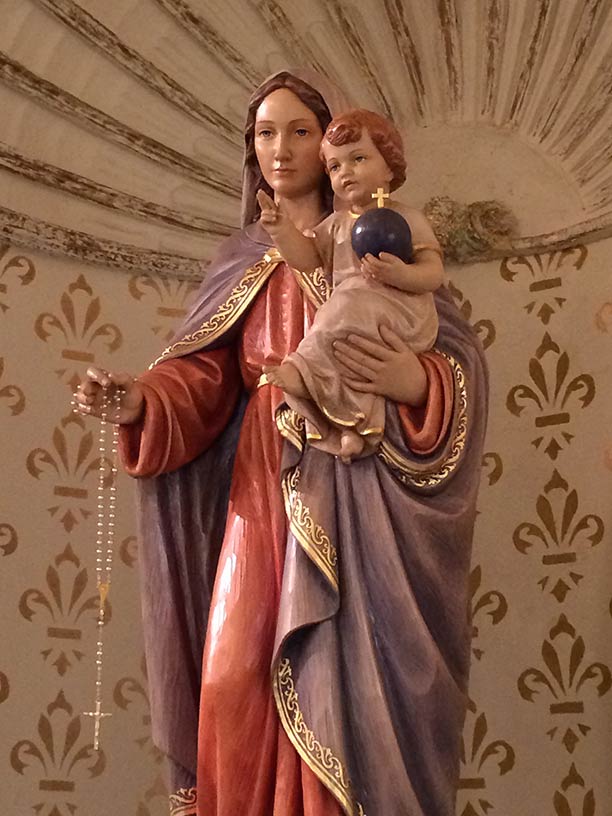Holy Rosary Church
Location: 595 Third St. NW, Washington, D.C. 20001
Metro: Red line to Judiciary Square.
by Heather N. Turnbow
The following Novena of Petition was composed by Blessed Bartolo Longo, founder of the shrine of Our Lady of the Rosary of Pompeii, in 1879:
O Immaculate Virgin and Queen of the Holy Rosary, in these times of dead faith and triumphant impiety you have desired to establish your throne of Queen and Mother in the ancient land of Pompeii, the resting place of deceased pagans. From this place in which idols and demons were worshipped, you today, as the Mother of divine grace, shower the treasures of heavenly mercy far and wide. O Mary, from this throne upon which you graciously reign, turn upon me as well your benign eyes, and have mercy on me who am so greatly in need of your help. Show yourself to me, just as you have shown yourself to so many others, as the true Mother of mercy, while I with all my heart greet you, and invoke you as my Sovereign and Queen of the Holy Rosary. Hail, Holy Queen.
The Holy Rosary Church was founded in 1913 as a parish of Italian immigrants, and continues to serve the Italian-American community in Washington, D.C. The founder of the parish, Father Nicholas De Carlo, had been seriously ill prior to his ordination as a priest in Italy, and vowed to build a church in honor of the Blessed Mother in thanks for his recovery.1 Mary Elizabeth Brown, An Italian American Community of Faith: Holy Rosary in Washington, D.C. 1913 – 2003 (New York: Center for Migration Studies, 2004), 18-19.The new parish originally met in a converted house on H Street, until the construction of the present church was completed in 1923 and dedicated to Our Lady of the Holy Rosary (fig. 1). This title comes from the 13th century vision of St. Dominic, in which Mary gave him a rosary as a tool of prayer and safeguard against heretics.2 Butler’s Lives of the Saints: New Full Edition, vol.10, October (Tunbridge Wells: Burns and Oats, 1997), 43-44.
The architectural firm Maginnis and Walsh designed the church in the style of a Medieval Roman basilica; this was an unusual choice at the time, since the neo-Gothic style prevailed in church architecture in Washington, D.C.3 Brown, Holy Rosary, 58.The simple façade has three entrance portals and a bell tower to the right. The interior consists of a central nave and two side aisles, Corinthian columns supporting a barrel-vaulted ceiling, and beautifully crafted stained glass, mosaics, paintings and statues (fig. 2).
Most of the artwork was created between 1925 and 1930, and financed primarily through the gifts of church members and other Catholic societies. The first image that greets visitors on the exterior of the church is a mosaic of the Virgin and Child above the central portal (fig. 3). The simple composition is reminiscent of Byzantine icons, depicting Mother and Child, both holding rosaries, against a glittering gold background. Upon entering the church, the visitor’s attention is immediately captured by the large oil painting above the altar, Queen of the Holy Rosary by Roman artist Romano Fattorini (fig. 4).4 Brown, Holy Rosary, 78-80.The Virgin sits enthroned on clouds with the Christ Child on her lap, both holding rosaries, surrounded by adoring angels. Mary’s brilliant blue veil and rose-red gown stand out boldly against the softly glowing background and pastel tones of the angel’s dresses, and her halo is bordered with six stars. While the stars and the colors of her clothing are in keeping with typical images of the Lady of the Holy Rosary, it is unusual that the figure of St. Dominic is absent, since he normally appears kneeling and accepting the rosary.5 For example, see the revered painting of Our Lady of the Holy Rosary of Pompeii: “Icona della Vergine,” Pontificio Santuario della Vergine del Rosario di Pompei. 2014. Nov. 13, 2014. http://www.santuario.it/.
The stained glass windows were created by Franz Mayer in Munich, Germany, and depict subjects related to the Mysteries of the Rosary that believers meditate upon during prayer, including the Joyful Mysteries of the Annunciation, Visitation, Nativity, Presentation at the Temple, and Jesus with the Temple Elders, and the Glorious Mystery of the Coronation of the Queen of Heaven.6 The Modern Catholic Encyclopedia, s.v. “Rosary” (Collegeville, MN: The Liturgical Press, 1994). These events are rendered in rich jewel tones, in a naturalistic style reminiscent of late Renaissance paintings. Especially noteworthy is the Annunciation window (fig. 5), in which Mary is depicted with the golden hair, fair skin, and sweet, graceful demeanor of a Botticelli figure. She kneels demurely in front of her Bible as the Angel Gabriel descends carrying white lilies (alluding to Mary’s purity), and the dove of the Holy Spirit casts divine light upon her.
The church’s tradition of artistic patronage by parishioners continues to the present day; in 2007, a statue of Our Lady of the Rosary of Pompeii (figs. 6-7) was donated by Veronica Nobilio in memory of her late husband.7 Sherri Watkins, “Newly Restored Holy Rosary Church rededicated by Archbishop Donald W. Wuerl,” Voce Italiana, October 7, 2007. This title for Mary refers to a painting of Our Lady of the Rosary that was brought to a restored church near Pompeii in southern Italy in the 1870’s, and performed a series of miraculous healings.8 “Beato Bartolo Longo,” Pontificio Santuario della Vergine del Rosario di Pompei. Web.The statue, a standing figure of Mary holding the Christ Child, is the centerpiece of a shrine to the right of the main altar, where visitors may light votive candles and kneel in prayer. Statues of St. Joseph and St. Gabriel frame the central niche. While Mary holds a rosary in her right hand, the baby Jesus holds an orb with a cross on top, a traditional motif from early Christian art symbolizing His dominion over the world. Pilgrims are invited to kneel and pray the rosary, meditating on the Joyful Mysteries depicted in the church’s stained glass windows.
For more information visit Holy Rosary Church.
References
| 1. | ⇧ | Mary Elizabeth Brown, An Italian American Community of Faith: Holy Rosary in Washington, D.C. 1913 – 2003 (New York: Center for Migration Studies, 2004), 18-19. |
| 2. | ⇧ | Butler’s Lives of the Saints: New Full Edition, vol.10, October (Tunbridge Wells: Burns and Oats, 1997), 43-44. |
| 3. | ⇧ | Brown, Holy Rosary, 58. |
| 4. | ⇧ | Brown, Holy Rosary, 78-80. |
| 5. | ⇧ | For example, see the revered painting of Our Lady of the Holy Rosary of Pompeii: “Icona della Vergine,” Pontificio Santuario della Vergine del Rosario di Pompei. 2014. Nov. 13, 2014. http://www.santuario.it/. |
| 6. | ⇧ | The Modern Catholic Encyclopedia, s.v. “Rosary” (Collegeville, MN: The Liturgical Press, 1994). |
| 7. | ⇧ | Sherri Watkins, “Newly Restored Holy Rosary Church rededicated by Archbishop Donald W. Wuerl,” Voce Italiana, October 7, 2007. |
| 8. | ⇧ | “Beato Bartolo Longo,” Pontificio Santuario della Vergine del Rosario di Pompei. Web. |



